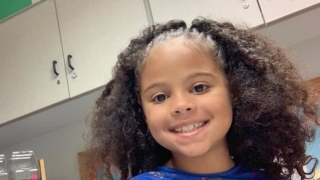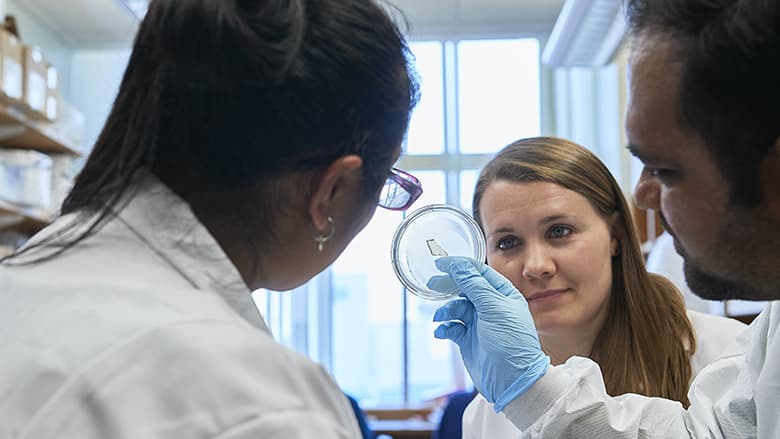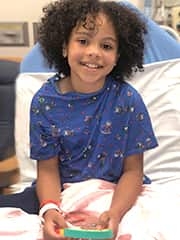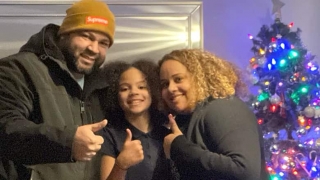Eosinophilic Esophagitis: Princess’ story
Published on
Published on
For as long as 11-year-old Princess can remember she’s had the same wish every Christmas: to feel better. This year, her wish is finally coming true – thanks to a dedicated team of clinicians from Children’s Hospital of Philadelphia, a new medication undergoing a clinical trial, and the unwavering support of her family.
 Princess has struggled with food allergies since she was an infant, developing symptoms to her mother’s breast milk and traditional formulas. Finally, Princess began to gain weight and started to meet early developmental milestones with a specialized milk formula alternative.
Princess has struggled with food allergies since she was an infant, developing symptoms to her mother’s breast milk and traditional formulas. Finally, Princess began to gain weight and started to meet early developmental milestones with a specialized milk formula alternative.
When it was time to transition Princess to solid foods, her mother Checa encountered more challenges. Despite the careful and slow way Checa introduced individual foods to Princess, the baby reacted negatively to most new foods – sometimes breaking out in hives, other times vomiting. At 18 months old, Princess could only tolerate a handful of foods including sweet potatoes, mashed potatoes and some cereals.
An incident at a babysitter’s house convinced Checa she couldn’t handle her daughter’s issue alone. The babysitter made mac and cheese and offered it to Princess, who liked it and ate it. “When I arrived to pick Princess up, she looked like a monster,” Checa said. “Her face was swollen, and one eye was nearly completely closed. I rushed her to the ER, where they gave her epinephrine and the ER doctor recommended we see an allergist.”
A visit to a local allergist confirmed what the ER doctor suspected: Princess was allergic to a slew of common food items including milk, egg, soy and more. Still, Checa wasn’t convinced food allergies were completely to blame for Princess’ symptoms.
“I really felt like it was more than allergies,” Checa says. “Something was very wrong with my child. I had no idea then it was going to turn into what it is now.”

Donor-funded research finds answers — and cures — for kids like Princess with rare diseases.
Checa brought Princess to Children’s Hospital of Philadelphia (CHOP) for help and answers. She’d had a previous positive experience at CHOP and felt staff would “listen to me and my concerns.”
Physicians in CHOP’s Division of Gastroenterology, Hepatology and Nutrition performed additional testing and diagnosed Princess with eosinophilic esophagitis (EoE), a rare and relatively unknown chronic inflammatory disease of the esophagus, the muscular tube that carries food from the throat to the stomach.
“When I heard that, I felt like my world stopped,” Checa says. “I was angry and scared. I blamed myself for not getting her help sooner.”
Thirty years ago, EoE was unknown, but diagnoses have risen dramatically in the past decade. In 2006, CHOP created the Center for Pediatric Eosinophilic Disorders to diagnose and treat children with this condition.
 Doctors including Terri F. Brown-Whitehorn, MD, and Bridget C. Godwin, MD, helped Checa manage Princess’s condition – first by identifying foods that produced her EoE symptoms including milk, soy, legumes, peanuts, tree nuts, peaches, seafood, shellfish, plantains, bananas, corn and leeks – then by eliminating them from her diet and finding nutritional alternatives.
Doctors including Terri F. Brown-Whitehorn, MD, and Bridget C. Godwin, MD, helped Checa manage Princess’s condition – first by identifying foods that produced her EoE symptoms including milk, soy, legumes, peanuts, tree nuts, peaches, seafood, shellfish, plantains, bananas, corn and leeks – then by eliminating them from her diet and finding nutritional alternatives.
“There were so many things she couldn’t eat. And so many packaged foods had these ingredients in them,” Checa says. “It amplified my role as mom and protector. I had to bring natural food she could eat everywhere we went. I couldn’t count on anyone else knowing everything about her condition.”
Princess’ dad, Cesar, adds: “It breaks my heart to see my daughter not being able to have the same meals as I do. As her father, I wish there was more than could do to protect my little Princess.”
When Princess started school, food became a more complex issue. She couldn’t share food with friends and had to sit apart from other students to avoid possible cross contamination.
It was isolating for Princess and became even more challenging in second grade when she was put on an elemental diet and had to be tube fed in the school nurse’s office at lunch. Princess had an NG tube inserted into her nostril, down the back of her throat, into her esophagus and then her stomach to deliver liquid food to supplement her diet. Because the tube was uncomfortable to insert, Princess wore the NG tube at all times – making her difference more apparent to her peers and negatively impacting her self-esteem.
In fourth grade, the NG tube was removed at Princess’ request and a G-tube port was installed in her belly to provide nutritional support. During the day, Princess could eat limited table food with her friends; at night, she received supplemental nutrition via the G-tube to ensure her continued growth.
“After the NG tube was removed, her confidence soared,” Checa says.
Princess says the feeding switch made a tremendous improvement on her life:
“Before I was embarrassed because everybody knew something was wrong with me. Now, I can tell people what I want to about my condition. They see who I am, not what I have.”
Princess is now an active sixth grader who participates in gymnastics, art club and was recently chosen to be part of an elite choir at school. She also loves math, science and puzzles.
 In Spring 2021, Princess received more good news. She was eligible to participate in a clinical trial for a newer medication that could reduce the inflammation in her esophagus and allow her to slowly expand her diet.
In Spring 2021, Princess received more good news. She was eligible to participate in a clinical trial for a newer medication that could reduce the inflammation in her esophagus and allow her to slowly expand her diet.
“It was weird when I started eating real food again,” Princess says. “But now it’s pretty cool that I can eat like the other kids – even if I still have to be careful not to overdo it.”
Princess began participating in a medication research trial in May 2021. She returns to CHOP’s Philadelphia campus for treatment and must undergo regular endoscopies and blood draws to assess her progress. She records her symptoms in an electronic diary that clinicians review.
“For the first time in her life, her esophagus isn’t inflamed, and she has no symptoms of EoE,” Checa says. “It’s truly a miracle and we wouldn’t be here if it wasn’t for the staff at CHOP – from Dr. Brown-Whitehorn and Dr. Godwin, to Pam Scott-Bey, a medical assistant in allergy, Michele Shuker, MS, RD, CSP, LDN, from nutrition, Amanda Muir, MD, Alain J. Benitez, MD, Stephanie Marko, BSN, RN, and Leah Wilkey, BA, in research – they’ve always been there for us – every step of the way.”
“They’ve cried with us, celebrated with us and cared for us,” she adds. “They’ve truly become like family to us; and we can’t thank them enough.”